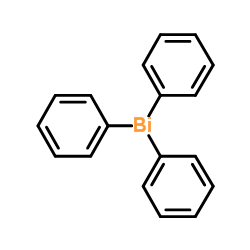Structural motifs in phenylbismuth heterocyclic carboxylates--secondary interactions leading to oligomers.
O Anjaneyulu, D Maddileti, K C Kumara Swamy
文献索引:Dalton Trans. 41(3) , 1004-12, (2012)
全文:HTML全文
摘要
The reaction of triphenylbismuth [BiPh(3)] with several heterocyclic carboxylic acids was explored. Seven crystalline compounds, [PhBi(2-O(2)C-3-(OH)C(5)H(3)N)(2)(2-O(2)C-3-(OH)C(5)H(3)NH)] (5), [(Bi(2-O(2)C-3-(OH)C(5)H(3)N)(4))(C(5)H(5)NH)(C(5)H(5)N)] (7), [PhBi(2-O(2)C-C(4)H(3)N(2))(2)(2-O(2)C-C(4)H(4)N(2))·H(2)O] (8), [PhBi(2-O(2)C-C(9)H(6)N)(2)·H(2)O] (9), [Ph(2)Bi(O(2)C-C(4)H(3)O)] (10), [Ph(2)Bi(O(2)C-C(4)H(3)S)] (11) and [PhBi(O(2)C-C(4)H(3)S)(2)](2) (12), were prepared by simple reactions using BiPh(3) and the corresponding acids, 3-hydroxypicolinic acid, pyrazine-2-carboxylic acid, quinoline-2-carboxylic (quinaldic) acid, furan-2-carboxylic acid and thiophene-2-carboxylic acid. Compound 5 primarily exhibits a coordination number of six with pentagonal pyramidal geometry at bismuth, but an additional weak Bi···O interaction in the direction of the lone pair of electrons is present. This feature leads to a weakly bound dimer. The use of pyridine as the solvent in a similar reaction, however, led to 7, in which all of the Bi-Ph bonds are cleaved. In this compound, bismuth exhibits a coordination number of eight and distorted dodecahedral geometry. In compound 8, the geometry around bismuth is primarily a pentagonal pyramid, however, clear-cut but weak secondary Bi···N interactions leading to a dimeric formulation are discernible in the structure. The quinaldate compound 9 exhibits a lower formal coordination number of five for bismuth, with square pyramidal geometry, but again two secondary Bi···O interactions for each bismuth in the direction of the lone pair lead to a dimer. A similar secondary Bi···O interaction involving furan oxygen is present in the furoate compound 10, which is a polymeric chain (one dimensional coordination polymer). Although the thiophene carboxylate 11 is also a polymeric chain, no Bi···S interactions are present. Unlike the previously reported tetrameric biscarboxylate [PhBi(2-O(2)C-C(5)H(3)N)(2)](4), the thiophene carboxylate [PhBi(O(2)C-C(4)H(3)S)(2)](2) (12) is a dimer considering only primary interactions. However, these dimers are arranged in such a way that there are secondary Bi···S interactions in the structure in the expected direction of the lone pair of electrons on bismuth. Thus, these studies suggest that the stereochemical activity (or inactivity) of the bismuth lone pair of electrons need to be judged more cautiously. TGA studies are consistent with the presence of Bi-Ph groups in all of the compounds, except 7, as indicated by their formulae.
相关化合物
| 结构式 | 名称/CAS号 | 分子式 | 全部文献 |
|---|---|---|---|
 |
三苯基铋
CAS:603-33-8 |
C18H15Bi |
|
Correlation of changes in the mandible and retina/choroid va...
2015-09-01 [J. Craniomaxillofac. Surg. 43 , 1144-50, (2015)] |
|
Cytotoxic effects of triphenylbismuth on rat thymocytes: com...
2002-10-01 [Environ. Toxicol. 17(5) , 472-7, (2002)] |
|
Osteolytic potential of triphenyl bismuth as an alternative ...
2005-10-01 [J. Biomed. Mater. Res. B. Appl. Biomater. 75Bth ed.,, 64, (2005)] |
|
Relativistic effects in triphenylbismuth and their influence...
2012-11-28 [Phys. Chem. Chem. Phys. 14(44) , 15520-4, (2012)] |
|
Development of a radiopaque, autopolymerizing dental acrylic...
1994-12-01 [J. Prosthodont. 3(4) , 213-8, (1994)] |